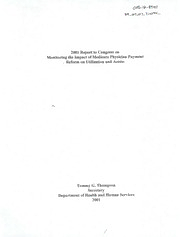
Report to Congress on monitoring the impact of Medicare physician payment reform on utilization and access PDF
Preview Report to Congress on monitoring the impact of Medicare physician payment reform on utilization and access
2001ReporttoCongresson MonitoringtheImpactofMedicarePhysicianPayment ReformonUtilizationandAccess TommyG.Thompson Secretary DepartmentofHealthandHumanServices 2001 TableofContents ExecutiveSummary Introduction PreviousReports The2001Report • cQhuaesntgieosnan1t:iDcoipeastetdhewiMtehdirecgaarredFteoeshSicfhtsedouflMeecdoinctairneuepatoymiennvtoskeftrhoemkpirnodcsedoufrpaalyment servicestowardevaluationandmanagementservices? Question2:Havetherebeenreductionsinaccesstophysicians'servicessince theintroductionoftheMedicareFeeSchedule? Question3:Haspaymentreformexacerbatedracialdifferencesinaccessto servicesthatwerereportedinearlieranalyses? Question4:AretheimpactsoftheMFSonphysicians'practicessimilarto earlierimpactsdetected? Conclusions References AppendixA ToC-1 Tables: Table1. MScehdeidcualreebAyllMoawjeodrCThyapregeosfSfoerrvPihcyesiCcaitaengso'ryS:er1vi9c9e0s-1P9a9i9dUndertheMedicareFee Table2. MedicarePerCapitaAllowedChargesforPhysicians'ServicesPaidUnderthe MedicareFeeSchedulebyMajorTypeofServiceCategory:1990-1999 Table3. MedicarePhysicians'servicesPaidUndertheMedicareFeeSchedule:Numberof VisitsandConsultationsper1,000AgedMedicareBeneficiaries:1990-1999 Table4. MedicarePhysicians'ServicesPaidUndertheMedicareFeeSchedule:Numberof Proceduresper1,000AgedMedicareBeneficiaries:1990-1999 Table5. MedicarePhysicians'ServicesPaidUndertheMedicareFeeSchedule:Numberof ImagingServicesper1,000AgedMedicareBeneficiaries:1990-1999 Table6. MedicarePhysicians'ServicesPaidUndertheMedicareFeeSchedule:Ratioof African-AmericantoWhiteVisitandConsultationUseRatesper1,000Aged MedicareBeneficiaries:1990-1999 Table7. MedicarePhysicians'ServicesPaidUndertheMedicareFeeSchedule:Ratioof African-AmericantoWhiteProcedureUseRatesper1,000AgedMedicare Beneficiaries:1990-1999 Table8. MedicarePhysicians'ServicesPaidUndertheMedicareFeeSchedule:Ratioof African-AmericantoWhiteImagingServicesUseRatesper1,000AgedMedicare Beneficiaries:1990-1999 Table9. MeasuresofAccesstoCareforAfrican-AmericanandWhiteMedicareBeneficiaries. DatafromtheMedicareCurrentBeneficiarySurvey:1991through1998 Table10. UsualSourceofCareforAfrican-AmericanandWhiteMedicareBeneficiaries. Data fromtheMedicareCurrentBeneficiarySurvey:1991through1998 Table11 HAofsrpiictaanl-iAzmaetrioincaanndanModrWtahliitteyARgateedsMfeordiScealreectBeedneHfeiacritaraineds:Va1s9c9u0laarndPr1o9c9e8duresfor Table12 HospitalizationandMortalityRatesforSelectedOrthopedicandBackProceduresfor African-AmericanandWhiteAgedMedicareBeneficiaries:1990and1998 Table13 HospitalizationandMortalityRatesforSelectedProceduresforAfrican-American andWhiteAgedMedicareBeneficiaries:1990and1998 ToC-2 Table14 HospitalizationandMortalityRatesforSelectedProceduresforAfrican-American andWhiteAgedMedicareBeneficiaries:1990and1998 Table15 PhysiciansBillingforMedicareServices,AverageCaseload,PaymentsperPhysician, PhysiciantoPopulationRatio,andTotalMedicarePayments,1995-1999:All Physicians Table16 PhysiciansBillingforMedicareServices,AverageCaseload,PaymentsperPhysician, PhysiciantoPopulationRatio,andTotalMedicarePayments,1995-1999:Primary CarePhysicians Table17 PhysiciansBillingforMedicareServices,AverageCaseload,PaymentsperPhysician, PhysiciantoPopulationRatio,andTotalMedicarePayments,1995-1999:Surgical Specialties Table18 PhysiciansBillingforMedicareServices,AverageCaseload,PaymentsperPhysician, PhysiciantoPopulationRatio,andTotalMedicarePayments,1995-1999:Medical Specialties ToC-3 EXECUTIVESUMMARY BACKGROUND This2001reporttoCongresson"MonitoringTheImpactofMedicarePhysicianPayment ReformonUtilizationandAccess"istheSecretary'sseventhannualreportsubmittedto CongressinresponsetorequirementsofPublicLaw101-239,theOmnibusBudget ReconciliationActof1989(OBRA'89). OBRA'89requiredtheSecretarytomonitor andreportannuallytheimpactofchangesinMedicarephysicianpaymentonutilization andaccesstocare. This2001reportisthelastreporttoCongressonthistopicin accordancewiththeFederalReportsEliminationandSunsetActof1995(P.L.104-66, Section3003). OBRA'89introducedsignificantchangesinMedicarephysicianpayment policy. Theintentofthechangeswastoprovidemorerationalandequitablepaymentfor physicians'servicesprovidedundertheMedicareprogram. THE2001REPORT KeyfindingsfrompastreportsindicatedthatintroductionoftheMedicareFeeSchedule (MFS)producedthekindsofshiftsinpaymentsthatwereanticipated. Inparticular,there wasarelativeincreaseinallowedchargesforvisitsandconsultationsandarelative decreaseinallowedchargesforprocedure-basedservices. Thepreviousreportsalso showedthatmanyvulnerablegroupsfacebarrierstocare. Whilethedifferencesamongvulnerablegroupsareacauseforconcern,pastreports showedthattheintroductionofthenewpaymentsystemforphysiciansproducednonew barrierstocareforthevulnerablepopulationsstudied. PreviousworkbytheHealthCare FinancingAdministrationandthePhysicianPaymentReviewCommissionhas establishedthatthenewpaymentsystemdidnotexacerbateexistingbarriers. The Secretary's2001reportfocusesonupdatingthetrendsinphysicianaccessshownin previousreportsanddescribesongoingeffortsbytheDepartmenttoreducedisparitiesin healthcare. This2001reportupdatesthreeofthebasicstudiesincludedinprevious reportsandaddsanewanalysisbasedonsurveysofMedicarebeneficiaries. FOURMAJORPOLICYISSUESADDRESSED • DoestheMFScontinuetoinvokethekindsofpaymentchangesanticipatedwith regardtoshiftsofMedicarepaymentsfromproceduralservicestowardevaluation andmanagementservices? • Havetherebeenreductionsinaccesstophysicians'servicessincetheintroduction oftheMFS? • Haspaymentreformexacerbatedexistingracialdifferencesinaccesstoservices? ES-1 • ArethereimpactsoftheMFSonphysicians'practices? HIGHLIGHTS • Theshiftinpaymentsdescribedinpreviousreports,fromproceduralservices towardevaluationandmanagementservices,wassustainedthrough1998andfor preliminaryestimatesfor1999. Priortophysicianpaymentreform,procedures includedunderthefeescheduleaccountedfor46percentofallowedcharges,and visitsandconsultsaccountedfor40percent. Thispatternwasreversedduring 1992,thefirstyearofphysicianpaymentreform. Datafrom1998andpreliminary 1999datashowthatvisitsandconsultscontinuetoaccountforanincreasingly largershareofallowedcharges(51percentofallowedcharges)thanprocedures (36percentofallowedcharges). • TotalMedicareallowedchargesforphysicians'servicesundertheMFSincreased byonly2.8percentduringtheperiod1995through1998,from$41.1billionto $42.2billion. Thislowrateofgrowthwasduemostlytoadecreasingnumberof Medicarebeneficiariesreceivingservicesinthefee-for-servicearea. Forthose beneficiariesreceivingcareinthefee-for-servicesector,percapitaallowed chargesforMFSphysicians'servicesincreasedby9.4percentduringtheseyears, from$1,292to$1,413. • Useofmosttypesofphysicians'serviceshaveincreasedsincetheintroductionof theMFS. Totalphysicianvisitsandconsultationshaveincreasedfrom12.2visits perpersonin1992to13.4visitsperpersonin1998. Physicianvisitsintheoffice setting,usuallyconsideredtheprincipalsiteforaccesstohealthcare,increased from5.4visitsperpersonin1992to6.5visitsperpersonin1998. Therewere alsoincreasesintheuseofanumberofproceduralandimagingcategoriesas well. Percapitauseratesincreasedbetween1992and1998by11percentfor coronaryarterybypassgrafts(CABG),80percentforpercutaneoustransluminal coronaryangioplasty(PTCA),22percentforcataractremovalwithlensimplant, 44percentforcomputedaxialtomographyscans,andby117percentformagnetic resonantimagingservices. Servicesforwhichthereweresignificantreductionsin userates,suchastransurethralprostatectomy,weremorelikelyduetochanging medicalpracticeunrelatedtopaymentpolicy. • WhiletheupdatedstudiescontinuetoshowthatAfrican-AmericanMedicare beneficiariesfacebarrierstocare,theaccessdifferentialshavenotworsenedandin somecasesappeartohaveimprovedslightly. Forexample,thereissomeevidenceto suggestthatAfrican-Americanbeneficiariesareexperiencingimprovedaccessto referral-sensitiveprocedures. Therateofcardiacrevascularizationprocedures (CABGandPTCA)isincreasingmorerapidlyamongAfrican-Americanbeneficiaries thanamongwhitebeneficiaries. Thishasresultedinanarrowingofthedifference ES-2 betweenwhiteandAfrican-AmericanMedicarebeneficiaries. Inaddition,disparities inthe30-daypost-admissiondeathrate,reflectingtosomeextentdifferencesinhealth statusatthetimeoftheprocedure,arediminishing. Forexample,in1998the30-day post-admissiondeathratesfollowingCABGwerenearlyequalforAfrican-American andwhitebeneficiaries,whileAfrican-Americanbeneficiarieshavelowermortality ratesthandowhitebeneficiariesfollowingPTCA. Asdiscussedabove,physicianofficevisitratesincreasedbetween1992and1998. However,theratesincreasedfasterforwhitebeneficiariesthanforAfrican-American beneficiaries. Asaresult,in1998African-AmericanMedicarebeneficiarieshad 19percentfeweroffice-basedphysicianvisitsthanwhitebeneficiaries,comparedtoa 14percentdifferentialin1992. Thisisoneofthefewareasinwhichtheracial differentialwasincreasing. Inaddition,African-Americanbeneficiarieshad39 percentmoreemergencyroomvisitsin1998thandidwhitebeneficiaries. Whilethe officevisitrateforAfrican-Americanswaslowerthanwhitesandtheemergency roomvisitratewashigher,thiswaspartiallymitigatedbythehigherrateof consultationsforAfrican-Americanbeneficiariesascomparedtowhitebeneficiaries. Moreover,othermeasuresofaccesstoprimarycare,basedondatafromtheMedicare CurrentBeneficiarySurvey,suggestthatbothwhiteandAfrican-American beneficiariesreportimprovedaccesstocare. IndicatorsforthenumberofphysiciansprovidingservicesundertheMFS,aswellas thenumberofuniqueMedicarepatientsseenbyaphysician(i.e..Medicarecaseload) andallowedcharges,continuetosuggestthataccesstophysicians'serviceshasnot deterioratedfollowingtheintroductionoftheMFS. Physiciansupplyincreasedby 3.8percentbetween1995and1998. However,duetodecreasingMedicare enrollmentinfee-for-service,thephysiciantoMedicarepopulationratioincreasedby over1 percentduringthistime. ES-3 INTRODUCTION ThisreporttoCongressfortheyear2001istheSecretary'sseventhannualreportsubmittedto CongressinresponsetorequirementsofPublicLaw101-239,theOmnibusBudget ReconciliationActof1989(OBRA'89). OBRA'89requiredtheSecretarytomonitorandreport annuallytheimpactofchangesinMedicarephysicianpaymentonutilizationandaccesstocare. ThisreportisthelastreporttoCongressonthistopicinaccordancewiththeFederalReports EliminationandSunsetActof1995(P.L.104-66,Section3003). OBRA'89introducedsignificantchangesinMedicarephysicianpaymentpolicy. Thethree majorcomponentsofthelawwere:(1)theintroductionofaMedicareFeeSchedule(MFS), whichwasimplementedbeginningJanuary1,1992,underatransitionperiodendingin1996;(2) theestablishmentoflimitsonphysicians'chargesexceedingthefeescheduleamount;and(3)the institutionoftargetratesofgrowthinexpendituresforphysicians'services. Theintentofthese changeswastoprovidemorerationalandequitablepaymentforphysicians'servicesprovided undertheMedicareprogram.1 Therehavebeenanumberofchangesinpaymentpolicyinrecent yearsaswell. Thefinalruleconcerningrevisionstopaymentpoliciesunderthephysicianfee scheduleforcalendaryear2000includeanumberofrevisionssuchasimplementationof resource-basedmalpracticeexpenserelativevalueunits(RVUs)andrefinementof resource-basedpracticeexpenses. PREVIOUSREPORTS TheHealthCareFinancingAdministration(HCFA)hastakenabroadandvariedapproachto monitoringaccesstocare. Previousreports(the1994,1995,and1996reportstoCongress) summarizedtheresultsofseveralstudies,whichprimarilyusedtheMedicarePartBmonitoring system,PartAdata,andtwonationalsurveys. Themulti-prongedapproachtomonitoringaccess tocarehasallowedHCFAtoexamineaccessfromvariousperspectives. 1 Asdescribedinpreviousreports,paymentreformispartofacontinuum. Beforethe OBRA'89reformswereinstituted,anumberofsignificantchangeswereinitiatedinphysician paymentpolicythataffected,andwillcontinuetoaffect,utilizationandaccess. Theseinclude theimplementationin1975oftheMedicareEconomicIndexasalimitonincreasesinprevailing charges;theinitiationin1984oftheparticipatingphysicianprogramtoprovideincentivesfor physicianstoacceptassignment;theintroductionin1987oftheMaximumAllowableActual Chargelimitswhichrestrictedtheamountnon-participatingphysicianscouldcharge;the reductionsinprevailingchargesforoverpricedproceduresinstitutedforonegroupofprocedures in1988andforanotherin1990;andtheinstitutionoffeeschedulesforradiologyin1989and anesthesiologyin1990. Manyotherforcesarealsolikelytocontinuetoinfluencethediffusion ofnewtechnologyintothehealthdeliverysystem. Itisimportant,therefore,toviewanychanges foundinaccess,utilization,andappropriatenessinlightofthemanyfactorsthatmayinfluence thehealthcaresystemingeneralandMedicareinparticular. 1 Inpreviousreports,severalvulnerablepopulationgroupswereidentifiedandmonitored. These includebeneficiarieswhoarelivinginpovertyareas;thoseduallyeligibleforMedicareand Medicaid;African-AmericanMedicarebeneficiaries;disabledMedicarebeneficiaries;thevery old(i.e.,age85andover);Medicarebeneficiarieswithoutsupplementalinsurance;Medicare beneficiariesresidinginruralareasorresidinginareasdesignatedashealthprofessionalshortage areas;andMedicarebeneficiariesresidinginareasexpectedtoexperiencethegreatestdecreases inaverageMedicarefees. Therewereseveralkeyfindingsfromthepastreports. Previousreportsshowedthatthe introductionoftheMFSproducedthekindsofshiftsinpaymentsthatwereanticipated. In particular,therewasarelativeincreaseinallowedchargesforvisitsandconsultationsanda relativedecreaseinallowedchargesforprocedure-basedservices. However,thesereportsalsoshowedthatmanyvulnerablegroupsfacebarrierstocare. For example,theyshowedthatraceandincomearemajorfactorsthatinfluencetheamountandtype ofservicesMedicarebeneficiariesreceive. African-AmericanMedicarebeneficiaries,regardless ofincome,visitedaphysicianlessfrequentlythanwhitebeneficiaries,receivedfewerpreventive services,butwerehospitalizedmoreoften. Amongbothraces,thepoorestoftheelderlyhad fewerphysicianvisitsandpreventiveservices,butwerehospitalizedmoreoftenthanthemost affluent. ThesepatternssuggestthatAfrican-Americanbeneficiariesoverallandthepoorestof bothracesmaybereceivinglessprimaryandpreventivecarethanwhitesandmoreaffluent Medicarebeneficrafiesinbothraces. Similarly,thefindingsinthepreviousreportsalsosuggestthatAfrican-Americanandlow- incomeMedicarebeneficiariesarereceivinglessthanoptimalmanagementofdisease. In particular,African-AmericanandlowerincomewhiteMedicarebeneficiarieshaveahigherrate ofbilateralorchiectomy,aprocedureperformedforlatestageprostatecancer. African-American andlow-incomeMedicarebeneficiariesalsohavehigherratesofhospitaladmissionfor conditionsthatarepotentiallyavoidablewithtimelyandappropriateambulatorycare (ambulatorycaresensitiveconditions). Anarticlebasedondatadevelopedforthesereports (Gornick,Eggers,Reillyetal.1996)highlightedtheanalysesthatshowedthatAfrican-American andlowerincomewhiteMedicarebeneficiariesarealsomorelikelytohaveanamputationofall orpartofthelowerlimb,aprocedureoftenperformedbecauseofcomplicationsofdiabetes. Inadditiontoindicationsoflessthanoptimalprimarycareandmanagementofdisease,the findingsfrompastreportsalsosuggestthatAfrican-AmericanMedicarebeneficiarieshaveless accessthanwhitebeneficiariestoreferral-sensitiveprocedures2. Forexample,African-American Medicarebeneficiarieshavelowerratesofcoronaryarterybypassgraft(CABG),percutaneous transluminalcoronaryangioplasty(PTCA),andjointreplacementsthanwhitebeneficiaries. Whilethesedifferencesbetweenvulnerablegroupsareacauseforconcern,previousreportsdid notfindevidencethattheintroductionofthenewpaymentsystemforphysiciansproducednew 2 Referral-sensitiveproceduresarethoseproceduresforwhichabeneficiarytypically receivesareferralfromaprimarycarephysiciantoaspecialist. 2 barrierstocareforthevulnerablepopulationsstudied. WorkbytheMedicarePayment AssessmentCommissionanditspredecessor,thePhysicianPaymentReviewCommissionalso foundnoevidenceofapaymentpolicyeffectonaccesstocare. Therefore,thecurrentreport focusesonupdatingthetrendsinphysicianaccessshowninpreviousreportsanddescribing ongoingeffortsbytheDepartmenttoreducedisparitiesinhealthcare. Thisreportupdatesthree ofthebasicstudiesincludedinpreviousreportsandaddsanewanalysisbasedonsurveysof Medicarebeneficiaries. THE2001REPORT Thisreportpresentsresultsfromupdatingthreeofthebasicstudiesincludedinpreviousreports. TsehreviPcaerstaBndmotnoiatsosreisnsgcshyasntgeemsiisnuascecdestsotuopdphaytseictoitaanls'exspeernvdiicteusrienggreonwertahl.forPaMrtFSAcdaotvaeraerdeused intheseanalysestoassesstrendsintheuseofin-patienthospitalservices. Thelevelofphysician participationinMedicare'sfee-for-serviceprogramisassessedthroughananalysisofMedicare's ProviderSummaryfiles. Finally,thisyear'sreportincludesanalysesoftrendsinaccesstocare usingtheMedicareCurrentBeneficiarySurvey.3 Thisreportexaminesthesamespecificpolicyissuesaddressedinpreviousreports: Question1: ^ DoestheMFScontinuetoinvokethekindsofpaymentchanges anticipatedwithregardtoshiftsofMedicarepaymentsfrom proceduralservicestowardevaluationandmanagementservices? Table1showsthetrendintotalallowedchargesforphysicians'servicescoveredundertheMFS fortheyears1990through1999. Between1990and1991allowedchargesincreasedby 10.4percent,from$29.9billionto$33.0billion,arateofincreaseconsistentwiththedouble digitpercentincreasesduringthe1970sand1980s. Therewasaslightdecreaseof0.8percentin allowedchargesin1992,thefirstyearoftheMFS. Thisreflectsthe8.2percentincreaseinvisits andconsults,offsetbya9.1percentdecreaseinprocedures. Increasesin1993,1994and1995 were4.0percent,11.5percent,and8.1percent,respectively. Thegrowthinexpenditures between1993and1994forprocedure-basedservices,ascomparedtothedecreasein expendituresbetween1992and1993,reflectsalargeadjustmenttothefeescheduleupdatein 1994forthesurgicalservices.4 From1995to1998allowedchargesincreasesbyonly 3 ThetablesinthisreportwithdatafromthePartBmonitoringsystemincludedatathrough 1999,thoughduetotheincompletenatureofthe1999data,analysesofthesetablesaregenerally through1998. MedicarePartAdataonhospitalizations,anddatafromtheMedicareCurrent BeneficiarySurveyarethrough1998. 4 Feescheduleupdateswerebasedonexpenditureperformancerelativetotheexpenditure targetsetundertheMedicareVolumePerformanceStandard(MVPS)from1992-1998. There wasabouta2-yeartimelagbetweentheperformanceyearusedtocalculatetheupdateandthe yeartheupdateactuallytakeseffect. Thatis,foraspecifiedgroupofservices,suchassurgery, theJanuary1,1994feescheduleupdatereflectsexpenditureperformanceduringfiscalyear 3
